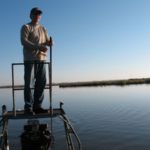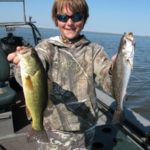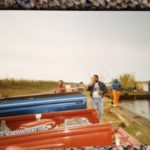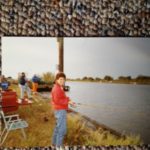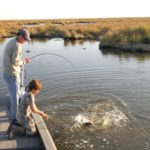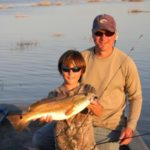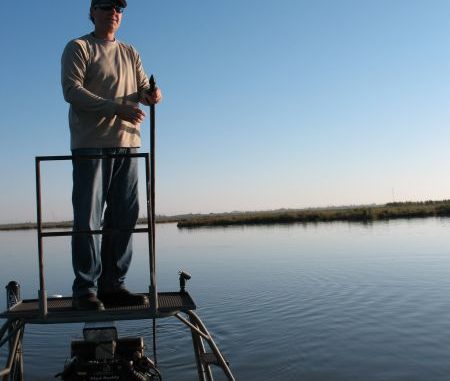
You could drive right through Myrtle Grove and never realize you’re passing up some top-notch redfishing grounds. This guide knows better.
Maybe you’ve thought of Myrtle Grove as a mere blip in the road, a tiny hamlet somewhere between Ironton and West Pointe a la Hache, a place you whiz by on your way to more notable destinations, such as Buras, Empire and Venice.
But it’s time to think again.
Certainly, many old timers remember Myrtle Grove as an outstanding wintertime bank-fishing destination, where you could pay a small fee and pull your car or truck up near the edge of Wilkerson Canal and fish for trout and redfish.
It was well known for producing excellent catches of specks and reds in the most inclement weather. It actually seemed that the colder and more bitter the winter weather was, the better your chances of catching fish.
Unfortunately for bank fishermen, that action stopped a good while before Hurricane Katrina hit, and the places we used to stand and fish are now occupied by some very expensive camps and residences.
But Myrtle Grove’s history goes way back before that. Eighty-nine-year-old Savare DeFelice, whose family owns 6,500 acres of marshland stretching from Myrtle Grove to beyond Lake Hermitage, remembers the area from the late 1920s to the present.
“I remember our family operated a store that catered almost exclusively to the trappers and fishermen who made their living in the marshes,” DeFelice said. “We’d sell or swap them products for pelts, and I can remember going to their camps in the marsh by boat to pick up furs. That was a long time ago.
“Then we bought a seafood cannery in Myrtle Grove in the 1940s, the Myrtle Grove Packing Company, where we canned shrimp and oysters. It was originally opened in the 1920s by a company out of Biloxi, and at the time there were six or seven canneries operating in Plaquemines Parish, on both sides of the river.
“At our peak we employed about 200 people, but as time passed and refrigerators and freezers became more popular, the seafood-canning industry really diminished, and we closed up in the mid 1950s. None of those canning companies survived.
“But back in the day, Myrtle Grove was a metropolis. There was a sugar mill, a bakery, a blacksmith shop, a grocery store and a hotel. Mr. Theodore Wilkerson had a canal dug out to Barataria Bay to bring in seafood from the Gulf and to provide better access by boat to Grand Isle.
“Back then, Grand Isle was a resort for more-wealthy people, and there were some nice hotels on the island. But access was difficult because of poor roads. Myrtle Grove became the best way to get mail and passengers and products to the island.
“I think Mr. Wilkerson’s original plan was to build a railroad track to Grand Isle and use the spoil from digging the canal as the bed for the track. But the dirt was all silt and it quickly dissolved into the marsh, and hurricanes wiped out the hotels on Grand Isle, and that plan was scrapped.”
Today Myrtle Grove consists of a couple dozen upscale fishing camps and residences, and a marina. But Wilkerson Canal still provides direct access to Barataria Bay and the Gulf and to some of the best fishing on either side of the river.
Charter Capt. Dave Marino operates Myrtle Grove Charters out of Myrtle Grove, and I rode with him recently through some of the area marshes. He told me the area generally swarms with redfish throughout the shallow ponds and along the shorelines of the big lakes and bays, and this is a great time of year to chase them.
“In December you have to let the weather dictate to you where and how to fish,” Marino said. “It could be cold and blustery, as those cold fronts blow down from the north and northwest with increasing regularity. Or it could be sunny and mild, either between the fronts or we often have such a mild winter it hardly shows up at all.
“Last year the winter was so mild we caught trout under a cork in the shallower lakes and bays all winter long. So, you go with what nature gives you.”
Marino said that on colder days when the water temperatures drop you’ll want to fish the bigger lakes and bays — such as Bay Round, Bay 5, Bay Laurier and Airplane Bay — and the deeper canals at cuts and drains and turns.
“The two bayous just above Petit Bay Chene Fleur have some real deep holes in the turns,” he said. “If you use your depth sounder you can see that in places it drops down to 40 feet deep.
“In real cold weather, the fish will go deep and huddle up, so once you locate them you can usually catch a limit in that spot.”
Marino grew up with a love for the water and a passion for fishing. As soon as he was able to drive, he started making trips to Myrtle Grove to fish off the bank for winter specks and reds. His enthusiasm was contagious, and soon he was bringing his mom out there with him.
“Back then you’d load up your trunk with Igloos and a thermos, your tackle and gear, sandwiches and snacks, and you’d back up close to the canal,” he said. “You’d really have to bundle up against the cold. We’d bring lawn chairs and sit or stand and fish. I have a lot of great memories fishing along the bank of the Wilkinson Canal with my mom.
“Once they developed the subdivision that all stopped, but the canal is still an excellent place to catch winter-time reds and specks. You just have to do it from a boat now.”
The area obviously made a deep impression on Marino because he and his family are now full-time residents of the subdivision.
Shallow-water reds
“Shallow-water fishing is really my preference and my specialty,” Marino said, “which is why I love to fish out of this boat.”
He was referring to his 20-foot Gaudet custom flatboat — 48 inches wide across the floor with a 7-foot poling platform in the back and a 55-horsepower Mudbuddy engine.
“This is a big boat for a mud boat, but it’s perfect for my application,” Marino said. “I like to fish where it’s very shallow, so shallow the redfish can’t hide. I climb onto the platform and pole the boat in water you’d never be able to fish in with an outboard motor.
“From that perch I can see farther and deeper than you can from inside the boat. If there’s a redfish in the area, I’ll spot it.”
After that it’s just a matter of getting a shot at the fish.
“Then I’ll pole the boat silently to within casting distance and you can sight-cast to it,” Marino said. “You toss your bait a couple feet in front of the fish, and you can watch them eye it up and then attack it.
“It’s a thrill you can’t believe until you experience it — and once you do, you’re hooked!”
For bait, Marino has a few preferences.
“I fish soft plastics, mostly black or black/chartreuse, and usually on a worm hook instead of the typical jighead,” he said. “I like the Ribbit frogs or single-tail Bass Assassins, on a worm hook, with the hook buried in the bait so you can fish it weedless around the grass. And because it’s so light, it drops into the water almost silently so the big splash of a heavy bait doesn’t spook the fish in the shallow water. We have a lot of success with that particular bait.”
But there are other options.
“My other favorites are weedless gold spoons, or beetle-spins with a black/chartreuse H&H Baby Bull Minnow,” Marino said. “That’s for redfish. I don’t like to fish market baits (dead shrimp) like many anglers do. I just never did like the park-at-a cut-and-soak-dead-bait-on-the-bottom-or-under-a-cork thing.”
Of course, sometimes his hand is forced.
“There are times when the conditions are poor and you don’t have much other choice,” Marino said of using market bait. “Then, I’ll usually fish a white Gulp! shrimp under a cork.
“But I’d much rather troll or pole, and be on the move and actively hunt for the fish.”
He said his approach is the best of all sporting worlds.
“I like the fact that this is both hunting and fishing,” Marino said. “Think about it: A hunter doesn’t ‘blind shoot.’ You don’t shoot into a bush and hope you hit an animal. You look for your target, and then you aim and shoot.
“That’s how I love to fish for reds. In the shallow water you can see them busting baits along the shorelines and around shallow islands, and you can see them moving through the water by the tell-tale V wake they leave behind them when they’re on the prowl. Toss just ahead of them and they’ll inhale it, and the fight is on!”
Marino said the other tactic he uses is to troll along the shallow banks on the north and northwest side of the big lakes and bays, and scan for signs of bait in the water.
Lake Hermitage, Round Lake, Airplane Bay and Lake Laurier are some of his favorites for this kind of fishing.
“The reds will congregate in deeper holes when the water temperature is cold, but as soon as the sun gets up those fish spread out over the flats and along the shallow shorelines searching for prey,” he said. “I look for three things: One, clean water. It doesn’t have to be crystal clear, but clean enough so the fish can see your bait.
“Two, moving water. That is, current. You need some tide movement to trigger their instinct to feed. I prefer a falling tide, but any movement will work.
“Three, bait. Always look for signs of bait in the water. Right now there’s still some shrimp in the marsh, but they’ll get scarcer with every cold front. So, you probably won’t see much sign of shrimp in the marsh. But you will see baitfish, minnows, mullet — and that’s where the redfish will be, and maybe some trout, as well. That’s where you want to fish.”
And it’s possible to catch both reds and trout without moving around.
“If the weather warms up and we have a couple or three mild days in a row, you can actually fish for reds and trout in these same lakes and bays — just like you fish for them in the spring,” Marino said. “The redfish will patrol close to the points in the big lakes, and you can toss any of those same baits, just blind-casting at the points. The Berkley Gulp! white plastic shrimp fished under a cork is the best bet.
“And for trout, head out to the middle of the same lakes and fish along the white plastic PVC poles that mark the oyster reefs. Drift or troll, and cast those white Gulps! under a cork. If you get into some action, stick your Power-Pole and see if you can put some numbers in the box. When the action stops, resume your drift.
“You can repeat that process all morning and you’ll likely put a nice box of fish together.”
Editor’s Note: Capt. Dave Marino can be reached at 504-656-8192.
